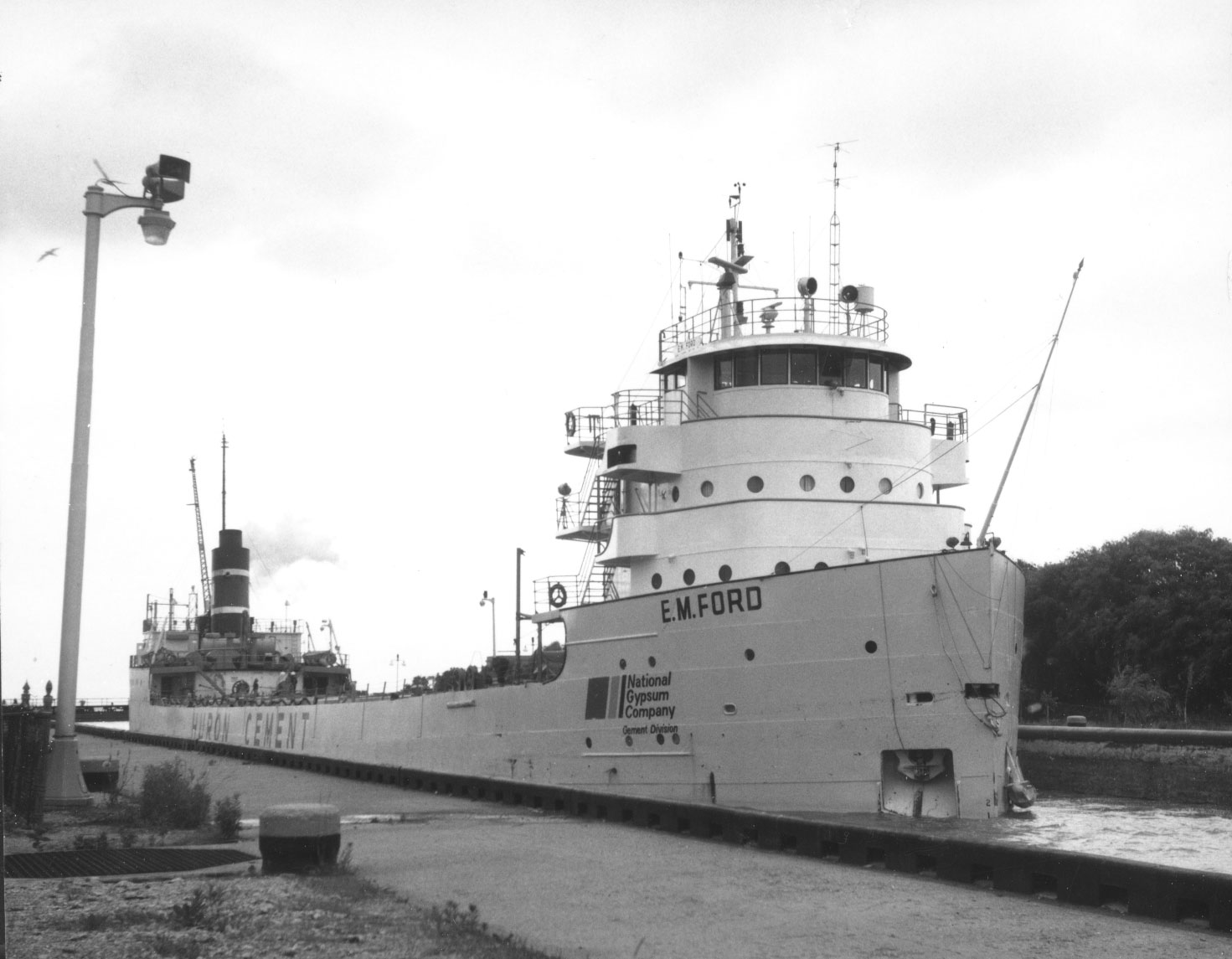Shipwreck: E.M Ford.
by Skip Gillham, Vineland, Ontario, CanadaAfter fifty-seven years as an iron ore carrier on the Great Lakes, the Cleveland-Cliffs freighter Presque Isle was due for retirement in 1955. It gained a reprieve, however, and was rebuilt as a specialized self-unloading, bulk cement carrier. It survives today in its third century of service, despite two serous accidents, and has reached the age of 108.
This vessel was built by the Cleveland Shipbuilding Co., and launched at Cleveland, Ohio, on May 25, 1898. The 428-ft long by 50-ft wide vessel was registered at 4,578 gross tons and joined Cleveland-Cliffs under their Presque Isle Transportation Company. It was the company flagship for several years until newer and larger bulk carriers assumed that honor.
Presque Isle usually loaded at the various iron ore docks around Lake Superior and delivered millions of tons of cargo to the lower Great Lakes ports. It operated through two World Wars, the Great Depression and the Korean conflict. The pace of service was accelerated by the battles and limited by the economic struggles of the nation.
On occasion Presque Isle returned up the lakes with coal and, on May 3, 1939, was the first ship of the new season at the Georgian Bay port of Midland, Ontario, arriving with a load of corn from Chicago.
Cleveland-Cliffs had no further need for a ship of this size by the mid-1950's so it was idle when sold to the Huron Portland Cement Company in 1955. They had the hull rebuilt to become a self-unloading cement carrier. Despite all the changes, it continued to be powered by the original 1,605 horsepower quadruple expansion engines, one of the last such power plants to serve on the Great Lakes. Later, in 1957-58, a new and larger pilothouse was installed in place of the original structure.
Renamed E.M. Ford, the ship returned to work on April 19, 1956, only to lose steering on the trial run and collide with the self-unloader A.M. Byers in the St. Clair River near Algonac, Michigan. Both ships received significant damage and the A.M. Byers sank in shallow water.
E.M. Ford was repaired and began hauling bulk cement from the Huron dock at Alpena, Michigan, to company storage silos around the Great Lakes. Between 1958 and 1977, the ship carried 898 cargoes and all were powdered cement. Most came aboard at Alpena and these were mainly taken to Green Bay, Saginaw, Milwaukee, Waukegan, Muskegon, St. Joseph, Detroit, Buffalo, Toledo and Cleveland. On twenty-three occasions E.M. Ford passed through the Welland Canal for the Lake Ontario port of Oswego, New York. The ship is shown in Lock Three on June 23, 1979.
Generally the Huron Cement boats were among the first to enter service each year and the last to tie up. Work was continuing late into 1979 when the vessel tied up at Milwaukee with 7,000 tons of cement.
It was Christmas so most of the crew were given leave to celebrate with their families. A winter storm lashed the area while most of the men were gone and the surging waves repeatedly bashed the E.M. Ford against the dock. The constant pounding opened a gash in the hull on December 25 and the crew on board could only watch their vessel settle at the dock. The water mixed with the cement to create a major problem.
Amazingly the E.M. Ford was repaired. It was salvaged, towed to Sturgeon Bay, Wisconsin, on March 3, 1980 and returned to service in the summer. It was idle in 1984 and 1985 but was given a refit in June 1986 and resumed work.
Huron Cement was purchased by Lafarge in 1987 and the ship now operated under the banner of Huron Transportation. It was inspected again in 1991 and certified for a return to service but was laid up at Superior, Wisconsin, in 1992. E.M. Ford was towed to Saginaw, Michigan, in 1996 for use as a storage hull.
Many hoped that the vessel would be reactivated for it centennial season in 1998 but the ship remained idle. It continues to serve as a storage barge but is well maintained. E.M. Ford has beaten the odds before but at 108 years old, chances of trading again under steam seem to have evaporated.

